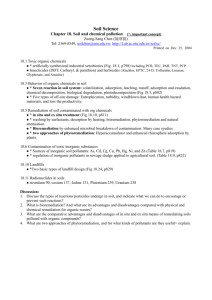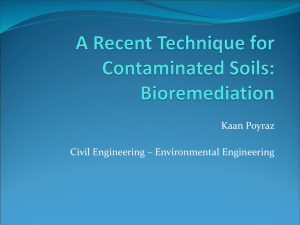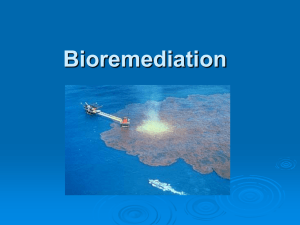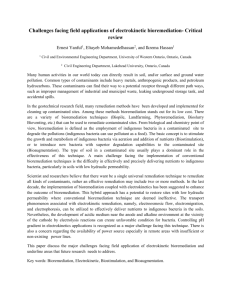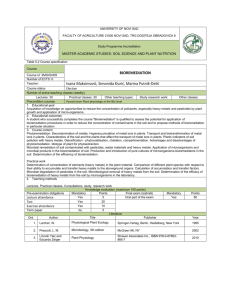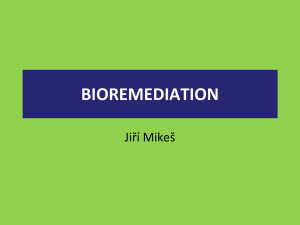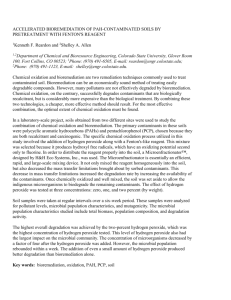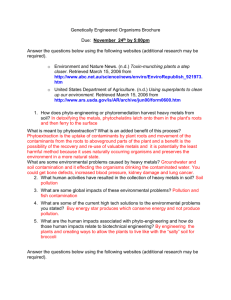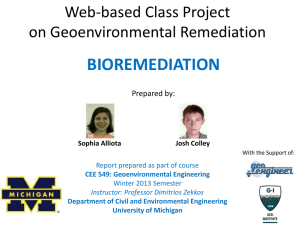bioremediation – a natural way for cleaner environment
advertisement
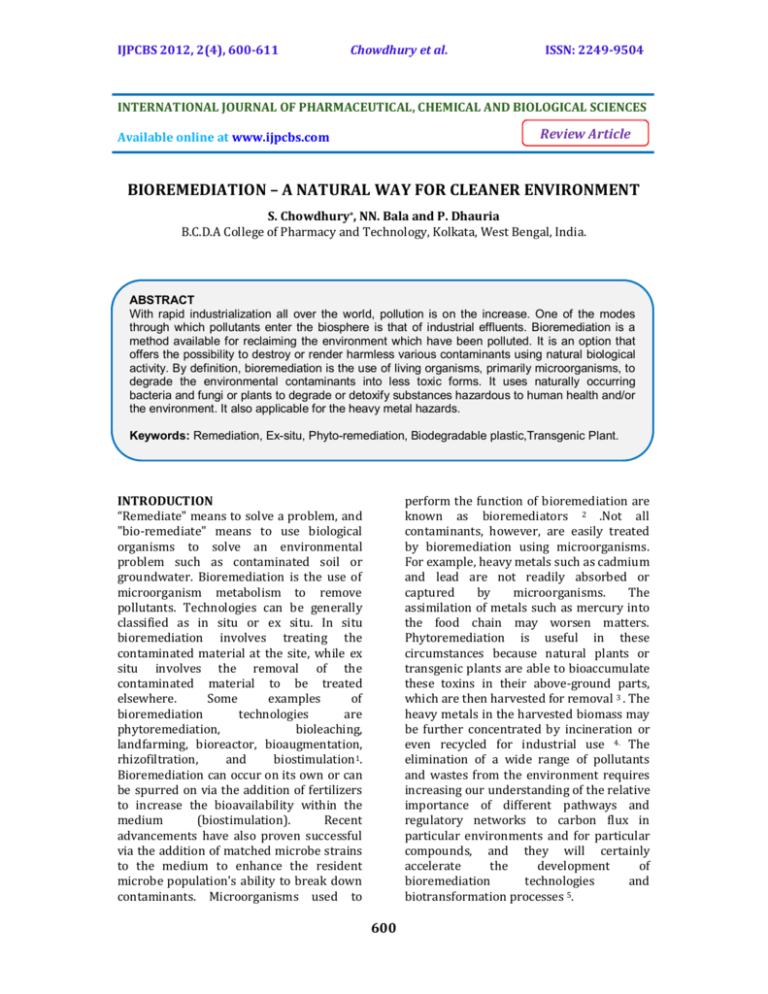
IJPCBS 2012, 2(4), 600-611 Chowdhury et al. ISSN: 2249-9504 INTERNATIONAL JOURNAL OF PHARMACEUTICAL, CHEMICAL AND BIOLOGICAL SCIENCES Review Article Available online at www.ijpcbs.com BIOREMEDIATION – A NATURAL WAY FOR CLEANER ENVIRONMENT S. Chowdhury*, NN. Bala and P. Dhauria B.C.D.A College of Pharmacy and Technology, Kolkata, West Bengal, India. ABSTRACT With rapid industrialization all over the world, pollution is on the increase. One of the modes through which pollutants enter the biosphere is that of industrial effluents. Bioremediation is a method available for reclaiming the environment which have been polluted. It is an option that offers the possibility to destroy or render harmless various contaminants using natural biological activity. By definition, bioremediation is the use of living organisms, primarily microorganisms, to degrade the environmental contaminants into less toxic forms. It uses naturally occurring bacteria and fungi or plants to degrade or detoxify substances hazardous to human health and/or the environment. It also applicable for the heavy metal hazards. Keywords: Remediation, Ex-situ, Phyto-remediation, Biodegradable plastic,Transgenic Plant. INTRODUCTION “Remediate" means to solve a problem, and "bio-remediate" means to use biological organisms to solve an environmental problem such as contaminated soil or groundwater. Bioremediation is the use of microorganism metabolism to remove pollutants. Technologies can be generally classified as in situ or ex situ. In situ bioremediation involves treating the contaminated material at the site, while ex situ involves the removal of the contaminated material to be treated elsewhere. Some examples of bioremediation technologies are phytoremediation, bioleaching, landfarming, bioreactor, bioaugmentation, rhizofiltration, and biostimulation1. Bioremediation can occur on its own or can be spurred on via the addition of fertilizers to increase the bioavailability within the medium (biostimulation). Recent advancements have also proven successful via the addition of matched microbe strains to the medium to enhance the resident microbe population's ability to break down contaminants. Microorganisms used to perform the function of bioremediation are known as bioremediators 2 .Not all contaminants, however, are easily treated by bioremediation using microorganisms. For example, heavy metals such as cadmium and lead are not readily absorbed or captured by microorganisms. The assimilation of metals such as mercury into the food chain may worsen matters. Phytoremediation is useful in these circumstances because natural plants or transgenic plants are able to bioaccumulate these toxins in their above-ground parts, which are then harvested for removal 3 . The heavy metals in the harvested biomass may be further concentrated by incineration or even recycled for industrial use 4. The elimination of a wide range of pollutants and wastes from the environment requires increasing our understanding of the relative importance of different pathways and regulatory networks to carbon flux in particular environments and for particular compounds, and they will certainly accelerate the development of bioremediation technologies and biotransformation processes 5. 600 IJPCBS 2012, 2(4), 600-611 Chowdhury et al. Why do we need bioremediation? Many substances with toxic properties have been brought into the environment through human activity. These substances vary in level of toxicity and danger to human health. Many of these substances eventually come in contact with and are isolated by soil. Conventional methods to remove, reduce, or mitigate toxic substances introduced into soil or ground water via human activities and processes include pump and treat systems, soil vapour extraction, incineration, and containment. Utility of each of these conventional methods of treatment of contaminated soil and/or water suffers from recognizable drawbacks and may involve some level of risk 6. The emerging science and technology of bioremediation offers an alternative method to detoxify contaminants 7.Bioremediation has been demonstrated and is being used as an effective means of mitigating: hydrocarbons halogenated organic solvents halogenated organic compounds non-chlorinated pesticides and herbicides nitrogen compounds metals (lead, mercury, chromium) radionuclides ISSN: 2249-9504 conditions for the optimal growth of the microorganisms added. Scientists have yet to completely understand all the mechanisms involved in bioremediation, and organisms introduced into a foreign environment may have a hard time surviving8 . 3. Intrinsic bioremediation This type of bioremediation occurs naturally in contaminated soil or water. This natural bioremediation is the work of microorganisms and is seen in petroleum contamination sites, such as old gas stations with leaky underground oil tanks. Researchers are studying whether intrinsic bioremediation happens in areas with other types of chemical contamination. Application of this technique requires close monitoring of contaminant degradation to ensure that environmental and human health are protected. Bioremediation Strategies Different techniques are employed depending on the degree of saturation and aeration of an area. In situ techniques are defined as those that are applied to soil and groundwater at the site with minimal disturbance. Ex situ techniques are those that are applied to soil and groundwater at the site which has been removed from the site via excavation (soil) or pumping (water).Bioaugmentation techniques involve the addition of microorganisms with the ability to degrade pollutants. The above three types bioremediation are strategies on two types- TYPES OF BIOREMEDIATION 1. Biostimulation Nutrients and oxygen - in a liquid or gas form - are added to contaminated water or soil to encourage the growth and activity of bacteria already existing in the soil or water. The disappearance of contaminants is monitored to ensure that remediation occurs. In situ bioremediation (at the site) These techniques are generally the most desirable options due to lower cost and less disturbance since they provide the treatment in place avoiding excavation and transport of contaminants. In situ treatment is limited by the depth of the soil that can be effectively treated. In many soils effective oxygen diffusion for desirable rates of bioremediation extend to a range of only a few centimeters to about 30 cm into the soil, although depths of 60 cm and greater have been effectively treated in some cases. The most important land treatments are: 2. Bioaugmentation Microorganisms that can clean up a particular contaminant are added to the contaminated soil or water. Bioaugmentation is more commonly and successfully used on contaminants removed from the original site, such as in municipal wastewater treatment facilities. To date, this method has not been very successful when done at the site of the contamination because it is difficult to control site 601 IJPCBS 2012, 2(4), 600-611 Chowdhury et al. Bioventing is the most common in situ treatment and involves supplying air and nutrients through wells to contaminated soil to stimulate the indigenous bacteria. Bioventing employs low air flow rates and provides only the amount of oxygen necessary for the biodegradation while minimizing volatilization and release of contaminants to the atmosphere. It works for simple hydrocarbons and can be used where the contamination is deep under the surface 9. ISSN: 2249-9504 Ex situ bioremediation (away from the site) These techniques involve the excavation or removal of contaminated soil from ground. Landfarming is a simple technique in which contaminated soil is excavated and spread over a prepared bed and periodically tilled until pollutants are degraded. The goal is to stimulate indigenous biodegradative microorganisms and facilitate their aerobic degradation of contaminants. In general, the practice is limited to the treatment of superficial 10– 35 cm of soil. Since landfarming has the potential to reduce monitoring and maintenance costs, as well as clean-up liabilities, it has received much attention as a disposal alternative. In situ biodegradation involves supplying oxygen and nutrients by circulating aqueous solutions through contaminated soils to stimulate naturally occurring bacteria to degrade organic contaminants. It can be used for soil and groundwater. Generally, this technique includes conditions such as the infiltration of watercontaining nutrients and oxygen or other electron acceptors for groundwater treatment. Composting is a technique that involves combining contaminated soil with nonhazardous organic amendants such as manure or agricultural wastes. The presence of these organic materials supports the development of a rich microbial population and elevated temperature characteristic of composting. Biosparging involves the injection of air under pressure below the water table to increase groundwater oxygen concentrations and enhance the rate of biological degradation of contaminants by naturally occurring bacteria. Biosparging increases the mixing in the saturated zone and thereby increases the contact between soil and groundwater. The ease and low cost of installing small-diameter air injection points allows considerable flexibility in the design and construction of the system10. Biopile are a hybrid of landfarming and composting. Essentially, engineered cells are constructed as aerated composted piles. Typically used for treatment of surface contamination with petroleum hydrocarbons they are a refined version of landfarming that tend to control physical losses of the contaminants by leaching and volatilization. Biopiles provide a favorable environment for indigenous aerobic and anaerobic microorganisms. Bioaugmentation frequently involves the addition of microorganisms indigenous or exogenous to the contaminated sites. Two factors limit the use of added microbial cultures in a land treatment unit: 1) nonindigenous cultures rarely compete well enough with an indigenous population to develop and sustain useful population levels and 2) most soils with long-term exposure to biodegradable waste have indigenous microorganisms that are effective degrades if the land treatment unit is well managed11-13. Bioreactors Slurry reactors or aqueous reactors are used for ex situ treatment of contaminated soil and water pumped up from a contaminated plume. Bioremediation in reactors involves the processing of contaminated solid material (soil, sediment, sludge) or water through an engineered containment system 14 . A slurry bioreactor may be defined as a containment vessel and apparatus used to create a threephase (solid, liquid, and gas) mixing condition to increase the bioremediation rate of soil bound and water-soluble 602 IJPCBS 2012, 2(4), 600-611 Chowdhury et al. pollutants as a water slurry of the contaminated soil and biomass (usually indigenous microorganisms) capable of degrading target contaminants. In general, the rate and extent of biodegradation are greater in a bioreactor system than in situ or in solid-phase systems because the contained environment is more manageable and hence more controllable and predictable. Despite the advantages of reactor systems, there are some disadvantages. The contaminated soil requires pre treatment (e.g., excavation) or alternatively the contaminant can be stripped from the soil via soil washing or physical extraction (e.g., vacuum extraction) before being placed in a bioreactor. ISSN: 2249-9504 microorganisms. These nutrients are the basic building blocks of life and allow microbes to create the necessary enzymes to break down the contaminants. All of them will need nitrogen, phosphorous, and carbon. Carbon is the most basic element of living forms and is needed in greater quantities than other elements. In addition to hydrogen, oxygen, and nitrogen it constitutes about 95% of the weight of cells. Environmental requirements Optimum environmental conditions for the degradation of contaminants are reported in Table. Microbial growth and activity are readily affected by pH, temperature, and moisture. Although microorganisms have been also isolated in extreme conditions, most of them grow optimally over a narrow range, so that it is important to achieve optimal conditions. If the soil has too much acid it is possible to rinse the pH by adding lime. Temperature affects biochemical reactions rates, and the rates of many of them double for each 10 °C rise in temperature. Above a certain temperature, however, the cells die. Plastic covering can be used to enhance solar warming in late spring, summer, and autumn. Available water is essential for all the living organisms, and irrigation is needed to achieve the optimal moisture level. The amount of available oxygen will determine whether the system is aerobic or anaerobic. Hydrocarbons are readily degraded under aerobic conditions, whereas chlorinated compounds are degraded only in anaerobic ones. To increase the oxygen amount in the soil it is possible to till or sparge air. In some cases, hydrogen peroxide or magnesium peroxide can be introduced in the environment. Soil structure controls the effective delivery of air, water, and nutrients. To improve soil structure, materials such as gypsum or organic matter can be applied. Low soil permeability can impede movement of water, nutrients, and oxygen; hence, soils with low permeability may not be appropriate for in situ clean-up techniques 16. Factors of bioremediation i. The existence of a microbial population capable of degrading the pollutants. ii. The availability of contaminants to the microbial population. iii. The environment factors (type of soil, temperature, pH, the presence of oxygen or other electron acceptors, and nutrients). Microbial populations for bioremediation processes Microorganisms can be isolated from almost any environmental conditions. Microbes will adapt and grow at subzero temperatures, as well as extreme heat, desert conditions, in water, with an excess of oxygen, and in anaerobic conditions, with the presence of hazardous compounds or on any waste stream. The main requirements are an energy source and a carbon source. Because of the adaptability of microbes and other biological systems, these can be used to degrade or remediate environmental hazards. Environmental factors15 Nutrients Although the microorganisms are present in contaminated soil, they cannot necessarily be there in the numbers required for bioremediation of the site. Their growth and activity must be stimulated. Biostimulation usually involves the addition of nutrients and oxygen to help indigenous 603 IJPCBS 2012, 2(4), 600-611 Chowdhury et al. What are environmental contaminants? Pollutants naturally-occurring compounds in the environment that are present in unnaturally high concentration. Example: Refined oil, Phosphates, Plastics. ISSN: 2249-9504 nucleic acids that make up microbial cells. Microorganisms take up carbon and nitrogen from the soil, water, and air around them. In order to take up nutrients and make them into cell parts, a microorganism needs energy. This is where catabolism comes in. Xenobiotics Chemically synthesized compounds that have never occurred in nature. Examples: Herbicides, Pesticides. 3. Catabolism – breaking down Catabolism allows microorganisms to gain energy from the chemicals available in the environment. Although most microorganisms are exposed to light and to chemical energy sources, most rely on chemicals for their energy. When chemicals break down, energy is released. Microorganisms use this energy to carry out cellular functions. HOW does bioremediation works? Bioremediation depends on the natural biological processes of microorganisms, one of which is metabolism. 1. Microbial metabolism Metabolism refers to all the chemical reactions that happen in a cell or organism. All living processes are based on a complex series of chemical reactions. Metabolic processes fall into two types – those that build complex molecular structures from simpler molecules, called anabolism, and those that break down complex molecules into simpler molecules, called catabolism. Chemicals present in contaminated sites can be remediated through either, or both, of these Processes. Fundamentals of cleanup reactions 17 Aerobic metabolism Microbes use O2 in their metabolism to degrade contaminants. Examples of aerobic bacteria recognized for their degradative abilities are Pseudomonas, Alcaligenes, Sphingomonas, Rhodococcus, and Mycobacterium. These microbes have often been reported to degrade pesticides and hydrocarbons, both alkanes and polyaromatic compounds. Many of these bacteria use the contaminant as the sole source of carbon and energy. 2. Anabolism – building up In anabolism, chemicals taken up by the microorganism are used to build various cell parts. Carbon and nitrogen are the basic chemicals in the proteins, sugars and Anaerobic metabolism18 Microbes substitute another chemical for O2 to degrade contaminants. 604 Nitrate, iron, sulfate, carbon dioxide, uranium, technician, per chlorate. IJPCBS 2012, 2(4), 600-611 Chowdhury et al. Ligninolytic fungi Fungi such as the white rot fungus Phanaerochaete chrysosporium have the ability to degrade an extremely diverse range of persistent or toxic environmental pollutants. Common substrates used include straw, saw dust, or corn cobs 19. ISSN: 2249-9504 and industries are researching metals that undergo methylation, complexation, or changes in valence state. These are noteworthy processes because they aid with the mobility and bioavailability of metals. There is a large interest in microorganisms that can facilitate with the transformation and the removal of the metal contaminant 21 . Remediation of metals often involves five general approaches: isolation, immobilization, mobilization, physical separation, and extraction. Immobilization and mobilization involve bioremediation processes. Industries use a combination of more than one approach to properly treat metalcontaminated sites. The combination of the approaches can be cost-effective. Methylotrophs Aerobic bacteria that grow utilizing methane for carbon and energy. The initial enzyme in the pathway for aerobic degradation, methane mono-oxygenase, has a broad substrate range and is active against a wide range of compounds, including the chlorinated aliphatics trichloroethylene and 1, 2-dichloroethane 20 . For degradation it is necessary that bacteria and the contaminants be in contact. This is not easily achieved, as neither the microbes nor contaminants are uniformly spread in the soil. Some bacteria are mobile and exhibit a chemotactic response, sensing the contaminant and moving toward it. Other microbes such as fungi grow in a filamentous form toward the contaminant. It is possible to enhance the mobilization of the contaminant utilizing some surfactants such as sodium dodecyl sulphate (SDS). Bioremediation of arsenic Arsenic is a compound that is very toxic to many life forms. However, when arsenic is in its insoluble form, it is not a harmful compound. Arsenic in its insoluble form is found in minerals, such as arseno-pyrite. The oxidation of the insoluble form of arsenic results in its transformation. Chemical and microbial processes often facilitate this oxidation22. Bioremediation of various metals Today’s industrial world has contaminated our soil, sediment, and water sources with hazardous materials. Metal waste is often a result of industrial activities, such as mining, refining, and electroplating. Mercury, arsenic, lead, and chromium are often prevalent at highly contaminated sites. This fact holds significant challenges for industries because these metals are difficult to remove. Therefore researchers Bioremediation of chromium Chromium is found in rocks, animals, plants, and soil. The most common forms of chromium are Cr (II), Cr (III), and Cr (VI). Cr (III) appears naturally in the environment. Industrial processes produce chromium (II) and chromium (VI). The hexavalent chromium compounds (chromium VI) are industrial produced by the oxidation of chromium (II) compounds. The toxico- 605 IJPCBS 2012, 2(4), 600-611 Chowdhury et al. kinetics of a given chromium compound depends on the valence state of the chromium compound 23. Recent studies have shown that microorganisms are capable of altering the redox state of toxic metals, organometals, and radionuclide contaminants. Chromium is a metal compound that possesses a high oxidation state and high solubility. Chromium has many oxidation states, from - 2 to +6. These characteristics make the remediation process of chromium difficult 24. It is now recognized that sulphate-reducing bacteria are obligate anaerobic heterotrophs and can cause toxic metals to precipitate to insoluble metal sulphides. It is also known that biofilms can affect the sorption, transportation, and decomposition of metal and radionuclide pollutant species. These techniques are used to remediate chromium despite their challenges 25. ISSN: 2249-9504 Moreover, breathing mercury vapor has been documented to cause respiratory and acute renal failure. Organomercurial, in the form or methyl mercury, is also problematic for living organisms. This compound can efficiently distribute throughout the body. Unlike methyl mercury, inorganic forms of mercury, such as HgCl, is less efficient at crossing biological membranes. Inorganic forms of mercury primarily travel to visceral tissues; therefore the lower portions of the body are generally affected by inorganic forms of mercury. Mercuric forms affect the distribution rate and toxicity level of this metal within the body. The reduction of Hg (II) to Hg (0) is a way to remove oxidized mercury compounds and to reduce soluble mercury (Hg) from the atmosphere. As stated previously, mercuryresistant bacteria like Pseudomonas aerginosa can reduce Hg (II) to Hg (0). Reduction of mercury from Hg (II) to Hg (0) allows a decrease in the mercury concentration from a contaminated aquatic system 27-28. Bioremediation of lead Lead is a metal compound that can be found in all parts of the environment. Lead is a product of industrial activities like mining and manufacturing. Lead is a metal contaminant prevalent in Superfund, Department of Energy, and Department of Defense sites. It is a metal compound that needs to be removed as soon as possible from water and land sources. Research today is focusing on the precipitation of metal sulfides utilizing sulfate-reducing bacteria for bioremediation purposes. They also use passive treatment systems like compost for remediation 26. Groundwater contamination Biological waste water treatment is undoubtedly one of the most important biotechnological processes, which have been used for over a century to treat municipal and industrial wastewaters. Culture-independent molecular techniques have been used to study the diversity and physiology of ecologically important microorganisms in wastewater treatment processes29, A number of new exciting insights into the structure, function, and dynamics of complex microbial communities in wastewater treatment processes have been gained, which have significantly expanded our understanding of process design, operation and control. Microbes play a vital role in the cycling of nitrogen in wastewater treatment processes (including anaerobic ammonia oxidation processes) and methane fermentation processes.Here all ground level chemical pipe& upper surface chemical tank are break down and release chemical that contact the upper& lower surface water that sediment and effect in our human life 30. Bioremediation of mercury Mercury is a metal that can exist in three forms, metallic, mercurous, and mercuric. Toxicity of mercury is due to the ability of both organomercurial compounds and inorganic forms of mercury and their high affinity to bind to membranes. Organomercury compounds possess the ability to bind to membranes because they are lipid soluble. These characteristics allow mercury compounds to induce damage to membranes and inactivate periplasmic and cytoplasmic enzymes within a cell. 606 IJPCBS 2012, 2(4), 600-611 Chowdhury et al. ISSN: 2249-9504 Fig. Showing Ground Water Contamination Biodegradable plastics 31 Biodegradable plastics are plastics that will decompose in natural aerobic (composting) and anaerobic landfill environments. Biodegradation of plastics oc curs when microorganisms metabolize the plastics to either assimilable compounds or to humus-like materials that are less harmful to the environment. They may be composed of either bioplastics, which are plastics whose components are derived from renewable raw materials, or petroleum-based plastics which contain additives. units and the media and type of bacteria used to produce the polymer. Phytoremediation Phytoremediation (from Ancient Greek word (phyto, meaning "plant", and Latin remedium, meaning "restoring balance") describes the treatment of environmental problems (bioremediation) through the use of plants that mitigate the environmental problem without the need to excavate the contaminant material and dispose of it elsewhere. Phytoremediation consists of mitigating pollutant concentrations in contaminated soils, water, or air, with plants able to contain, degrade, or, eliminate metals, pesticides, solvents, explosives, crude oil and its derivatives, and various other contaminants from the media that contain those 33. Photo-biodegradable plastics Polymers that change structure when illuminated with UV radiation, forming biodegradable materials. Starch-linked biodegradable plastics Starch has been incorporated into the structure of some plastics that can be microbially degraded. Example of phytoremediation i. Sunflowers used to remove radioactive cesium and strontium from Chernobyl site. ii. Water hyacinths used to remove arsenic from water supplies in Bangladesh, India. Bacterial plastics32 A number of microbes naturally produce biodegradable polymers that are suitable for the plastics industry. For example, the bacterium Alcaligenes eutrophus produces the polyester polybeta-hydroxybutyrate (PHB) as a storage reserve for excess carbon. The monomeric unit of PHB is betahydroxybutyrate. The strength, flexibility and crystallanity of polymers are determined by the Type of repeating Application of phytoremediation Phytoremediation may be applied wherever the soil or static water environment has become polluted or is suffering ongoing chronic pollution. Examples where phytoremediation has been used successfully include the restoration of abandoned metal-mine workings, reducing 607 IJPCBS 2012, 2(4), 600-611 Chowdhury et al. the impact of sites where polychlorinated biphenyls have been dumped during manufacture and mitigation of on-going coal mine discharges 34. Phytoremediation refers to the natural ability of certain plants called hyper accumulators to bioaccumulate, degrade, or render harmless contaminants in soils, water, or air. Contaminants such as metals, pesticides, solvents, explosives, and crude oil and its derivatives, have been mitigated in phytoremediation projects worldwide. Many plants such as mustard plants, alpine pennycress, hemp, andpigweed have proven to be successful at hyper accumulating contaminants at toxic waste sites 35. ISSN: 2249-9504 f) Improve food quality by altering the composition of lipids, proteins and carbohydrates. g) Produce polypeptides for the use in medical & pharmaceutical use. h) Plants are made by altering the genetic makeup. i) This process is done in laboratory. It’s called Genetic engineering technique. j) Adding one or more genes of a plant’s genome. k) This technique has 2 methods. Biolistic method ( Particle gun). Agrobacterium tumefaciens mediated transformation. Application of transgenic plant 37 a) Production of peptides, proteins & enzymes of therapeutic and industrial use. b) Generation of antibodies & antibody fragments in plant. c) In vaccine production system. d) Modification of biogenetic pathways by manipulation of plant metabolism for the production of novel secondary metabolites. e) Several gene transfers have been aimed at improving the produce quality. f) Genes that provide resistance against plant viruses have been successfully introduced into such crop plants as tobacco, tomatoes, and potatoes. Transgenic plants36 a) Genetically modified plants are plants whose DNA is modified using genetic engineering techniques. b) They have genes inserted into them that are derived from another species. c) Transgenic plants are used to express protein like the cry toxins from Bacillus thuringiensis. d) Modify metabolic pathways for the production of low molecular weight compound & polymers. e) Increase resistance towards pests and stresses. Fig. Transgenic plants digest the chemical from the environment 608 IJPCBS 2012, 2(4), 600-611 Chowdhury et al. Bioremediation at our home Look for household, carpet, bathroom or drain cleaners with “enzyme action”. Those enzymes are bacterial enzymes, made by friendly bacteria in those products. Once the pollutant in our carpet or bathroom surface is gone, the bacteria run out of food, and die off. Some plants are known for their ability to improve air quality by absorbing indoor air pollutants such as formaldehyde, benzene and trichloroethylene 38. Formaldehyde is found in tobacco smoke and burning wood, and emitted by curtains, carpets, furniture, glues and household cleaning products. Benzene is a common solvent found in glues, oils, furniture wax, detergents and paints.Trichloroethylene is found in paints, adhesives, inks and varnishes. ISSN: 2249-9504 characterization of the environment where the contaminant exists, including the microbiology, geochemistry, mineralogy, geophysics, and hydrology of the system. Researches using bioremediation has shown great promise to date. Further researches in this field can result in the development of most efficient and less time consuming technologies. Also, further research is critical to investigate its application beyond the laboratory-scale and to develop the kinetics of degradation. Although public attitudes toward bioremediation are generally favorable, the lack of knowledge about microorganisms and their natural role in the environment could affect the acceptability of their use. Before bioremediation techniques to be used widely, their efficacy and safety will have to be convincingly demonstrated and communicated to the public. Advantages of bioremediation Works on a variety of organic and inorganic compounds. Can be done either on-site or off-site. Easy to implement and maintain. Low-cost compared to other treatment methods. Environmentally-friendly and aesthetically pleasing. Reduces the amount of wastes to be land filled. ACKNOWLEDGEMENT The authors wish to thank the authority of BCDA College of Pharmacy and Technology for providing the necessary infrastructure to make this paper work successful. REFERENCES 1. Baker, A. J. M.; Brooks, R. R. "Terrestrial higher plants which hyperaccumulate metallic elements – A review of their distribution, ecology and phytochemistry",Biorecovery . 1989;1 (2): 81–126. 2. Lovley, DR. "Cleaning up with genomics: applying molecular biology to bioremediation". Nature Reviews. Microbiology.2003; 1 (1): 35–44. 3. Meagher, RB. "Phytoremediation of toxic elemental and organic pollutants". Current Opinion in Plant Biology.2000; 3 (2): 153–162. 4. White C, Sayer JA, Gadd GM. Microbial solubilisation and immobilization of toxic metals: key biochemical processes for treatment of contamination. FEMS Microbiol Rev. 1997; 20:503-516. 5. Subramanian, Murali; Oliver, David J. & Shanks, Jacqueline V. "TNT Phytotransformation Pathway Disadvantages of bioremediation May take several years to remediate. May depend on climatic conditions. Restricted to sites with contamination near the roots. Harvested plants may be classified as hazardous waste. Consumption of contaminated plants may be harmful. Possible harmful effects on the food chain. CONCLUSION It is a new technique that has yielded both remarkable and yet some setback results. As to advantages, bioremediation is a “natural process”, it destroys the target chemicals, its’ usually less expensive than other technologies, and can be used where the problem is located. Before attempting to employ bioremediation technology, one need to conduct a thorough 609 IJPCBS 2012, 2(4), 600-611 Chowdhury et al. Characteristics in Arabidopsis: Role of Aromatic Hydroxylamines", Biotechnol. Prog. 2006; 22 (1): 208–216. 6. Desai JD, Banat IM. Microbial production of surfactants and their commercial potential. Microbiology and Molecular Biology Reviews .1997; 61: 47-64. 7. Meagher, RB. "Phytoremediation of toxic elemental and organic pollutants".Current Opinion in Plant Biology.2000; 3 (2): 153–162. 8. Dejonghe, W., Boon, N., Seghers, D., Top, E.M., and Verstraete, W. Bioaugmentation of soils by increasing microbial richness: Environ.Microbiol. 2001; 3, 649. 9. Malina, G., J.T.C. Grotenhuis, W.H. Rulkens, S.L.J. Mous and J.C.M de Witt. Soil Vapour Extraction versus Bioventing of Toluene and Decane in Bench-Scale Soil Columns. Environmental Technology.1998; 19:977-991. 10. Gierke, J. S. C. L. Wojick, J. M. Muraski-Smith, N. J. Hutzler. “Air Sparging Performance in a NAPLcontaminated, Sandy-gravel Aquifer.” Groundwater Quality: Remediation and Protection. 1998; 250. 119-124. 11. Dybas, M.J., Bezborodinikov, S., Voice, T., Wiggert, D.C., Davies, S., Tiedje, J.,Criddle, C.S., Kawka, O., Barcelona, M., and Mayotte, T. Evaluation of bioaugmentation to remediate an aquifer contaminated with carbon tetrachloride, in In situ and on-site bioremediation. 1997; 4, 507–512. 12. Dybas, M.J., Hyndman, D.W., Heine, R., Tiedje, J., Linning, K., Wiggert, D., Voice, T., Zhao, X., Dybas, L., and Criddle, C.S. Development, operation, and long-term performance of a full-scale biocurtain utilizing bioaugmentation, Environ. Sci. Technol. 2002; 36, 3635. 13. Ellis, D.E., Lutz, E.J., Odom, J.M., Buchanan, R.J., Jr., Bartlett, C.L., Lee, M.D.,Harkness, M.R., and Deweerd, K.A. Bioaugmentation for 14. 15. 16. 17. 18. 19. 20. 21. 22. 610 ISSN: 2249-9504 accelerated in situ anaerobic bioremediation, Environ. Sci. Technol. 2000. 34, 2254. Johnson, P. C. “Assessment of the Contributions of Volatilization and Biodegradation to In Situ Air Sparging Performance.” Environmental Science and Technology. 1998; 32(2): 276-281. Bizily, S.P., Rugh, C.L., and Meagher, R.B. Phytodetoxification of hazardous organomercurials by genetically engineered plants, Nat. Biotechnol. 2000; 18: 213. Gao S, Burau RG. Environmental factors affecting rates of arsine evolution from and mineralization of arsenicals in soil. J Environ Qual .1997; 26:753-763. Ford, C.Z., Sayler, G.S., and Burlage, R.S. Containment of a genetically engineered microorganism during a field bioremediation application, Appl. Microbiol. Biotechnol. 1999; 51, 397. Song, Y.C., Kwon, S.J., Woo, J.H. Mesophilic and thermophilic temperature co-phase anaerobic digestion compared with singlestage mesophilic- and thermophilic digestion of sewage sludge, Water Res. 2004 ;38(7):1653–62. Bennett, J.W. Mycotechnology: The role of fungi in biotechnology, J. Biotechnol. 1998; 66: 101. Kloos, D.U., Stratz, M., Guttler, A., Steffan, R.J., and Timmis, K.N. Inducible cell lysis system for the study of natural transformation and environmental fate of DNA released by cell death, J. Bacteriol. 1994; 17: 7352. Brim H, McFarlan SC, Fredrickson JK, Minton KW, Zhai M, Wackett LP, Daly MJ. "Engineering Deinococcus radiodurans for metal remediation in radioactive mixed waste environments". Nature Biotechnology. 2000; 18 (1): 85–90. Juerg Zobrist: Mobilization of Arsenite by Dissimilatory Reduction of Adsorbed Arsenate. Environmental Science Technology. 2000; 34, 4747-4753. IJPCBS 2012, 2(4), 600-611 Chowdhury et al. 23. Laxman, R.S., and More, S. Reduction of hexavalent chromium by streptomyces griseus, Mineral engineering, 2002;15(11), 831-837. 24. Kannan. V, Vijayasanthi. M , Chinnasamy. M :Bioremediation of chromium in tannery effluent by filamentous Cyanobacteria Anabaena flos-aquae West : Int. Journal of Env Sc. 2012; 2(4): 23602366. 25. Losi ME, Amrhein C, Frankenberger WT. Environmental biochemistry of chromium. Rev Environ Contam Toxicol.1994; 136:92-121. 26. Anushree Malik. Metal Bioremediation Through Growing Cells. Environmental International. 2003; 30: 201. 27. Marky Y. Vilensky, Brian Berkowitz, and Abraham Warshawsky: In situ Remediation of Groundwater Contaminated by Heavy-and Transition-metal Ions by Selective Ion-Exchange Methods. Environmental Science Technology. 2002; 36:1851-1855. 28. Irene Wagner-Dobler, Harald von Canstein, Ying Li, Kenneth N. Timmis, and Wolf-Dieter Deckwer. Removal of Mercury from Chemical Wastewater by Microorganisms in Technical Scale. Environmental Science. 2000; 34:346. 29. Rupassara, S. I.; Larson, R. A.; Sims, G. K. & Marley, K. A. , "Degradation of Atrazine by Hornwort in Aquatic Systems", Bioremediation Journal 2002; 6 (3): 217–224. 30. McCarty, Perry L. et al “Full-Scale Evaluation of In Situ Cometabolic Degradation of Trichloroethylene in Groundwater through Toluene Injection”. Environmental Science 31. 32. 33. 34. 35. 36. 37. 38. 611 ISSN: 2249-9504 and Technology. 1998, 32(1):88100. Yabannavar, A. V. & Bartha, R. Methods for assessment of biodegradability of plastic films in soil. Appl. Environ. Microbiol. 1994; 60:3608-3614. Chen, G , & Patel, M. Plastics derived from biological sources: Present and future: P technical and environmental review. Chemical Reviews.2012; 112(4): 2082-2099. J. Wang, ZZ Zhang, YM Su, W He, F He & HG Song, Phytoremediation of petroleum polluted soil, Petroleum Science.2008; 5 (2) : 167. Adler, P. R., S. T. Summerfelt, D. M. Glenn, and F. Takeda. Mechanistic approach to phytoremediation of water. Ecol. Eng. 2003; 20:251–264. Rupassara, S. I.; Larson, R. A.; Sims, G. K. & Marley, K. A. , "Degradation of Atrazine by Hornwort in Aquatic Systems", Bioremediation Journal .2002; 6 (3): 217–224. Hannink, N.; Rosser, S. J.; French, C. E.; Basran, A.; Murray, J. A.; Nicklin, S.; Bruce, N. C, "Phytodetoxification of TNT by transgenic plants expressing a bacterial nitroreductase", Nature Biotechnology .2001;19 (12): 1168– 72. Kay, E., Vogel, T.M., Bertolla, F., Nalin, R., and Simonet, P. In situ transfer of antibiotic resistance genes from transgenic (transplastomic) tobacco plants to bacteria, Appl. Environ. Microbiol. 2002; 68, 3345. Bej, A.K., Perlin, M.H., and Atlas, R.M. Model suicide vector for containment of genetically engineered microorganisms, Appl. Environ. Microbiol. 1988; 54: 2472.
